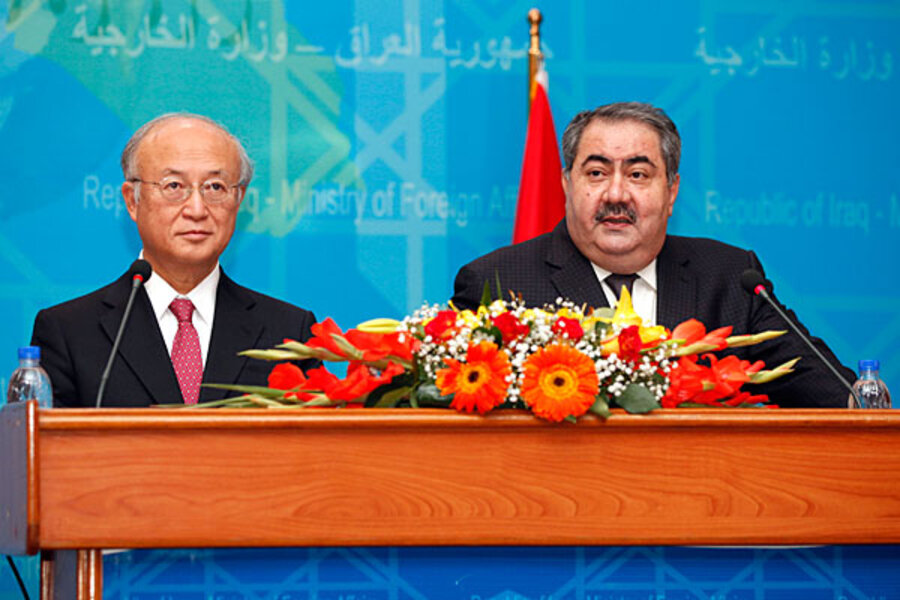IAEA: Iran making steady advances on nuclear program
Loading...
| Istanbul, Turkey
The UN's nuclear watchdog agency says Iran is making steady advances in its nuclear program, boosting its uranium enrichment capacity as diplomatic efforts to limit it nuclear work are due to resume.
Iran has, in the past three months, completed the installation of centrifuges at the small Fordow facility, built beneath a mountain south of Tehran, according to a report issued today by the International Atomic Energy Agency (IAEA). Echoing past reports, the IAEA criticized Iran for "not providing the necessary cooperation," which meant that the IAEA was unable to conclude that "all nuclear material in Iran is [used solely] in peaceful activities."
Iran's enrichment advances are monitored and conducted under IAEA safeguards. But the agency said Iran had prevented access for almost a year to Parchin – a site the IAEA believes was once used for weapons-related tests – while apparent cleansing activities were under way.
The IAEA also stated that "no concrete results had been achieved," despite an "intensified dialogue," on resolving longstanding allegations of weapons-related work. Iran rejects the charges, and the documents they are based on, as fabrications of hostile intelligence organizations.
The IAEA noted that Iran was in breach of several UN Security Council resolutions that require it to halt all enrichment work – a crucial sticking point in episodic nuclear negotiations this year, during which Iran has insisted on its "right" to enrich as a signatory of the Nuclear Non-Proliferation Treaty.
Today, the IAEA reported that Iran added 644 centrifuges for a total of 2,784 at Fordow, completing the site where Iran enriches uranium to 20 percent purity – a few technical steps away from weapons-grade of 90 percent.
But the IAEA report said that Iran had not increased the number of working centrifuges at the site – still just below 700, as it was three months ago – nor indicated when Fordow might be fully functional.
While the boost of capacity at Fordow grabs headlines, the IAEA also reported that Iran has converted more than 41 percent of the higher-enriched, 20 percent uranium it has produced into reactor fuel – rendering it virtually unusable for weapons.
The fate of Fordow has been a critical issue during the three rounds of nuclear talks this in which world powers aim to permanently prevent Iran from attaining a nuclear weapon.
International demands
Amid threats of military action from Israeli and American politicians – and an ever-increasing array of sanctions that have sharply damaged Iran's economy – negotiators of the so-called P5+1 group (the US, China, Russia, France, and the UK, plus Germany) met Iran in Istanbul, Baghdad, and Moscow with little tangible result.
The P5+1 demands that Iran halt all 20 percent enrichment, remove stockpiles from the country, and close down Fordow – which is effectively immune from attack by all but the most powerful bunker buster bombs.
Iran would also accept more intrusive inspections and other measures to prevent it from going for a nuclear weapon if it ever chose to – a step that US intelligence agencies say that Iran has not made.
So far, the P5+1 has not put substantial sanctions relief on the negotiating table, nor suggested officially that Iran can enrich uranium on its own soil.
Nuclear talks loom
The IAEA's latest quarterly report comes as nuclear discussions are due to resume after a months-long hiatus.
Catherine Ashton, the European Union foreign policy chief who has been been the lead negotiator for the P5+1, will meet political directors in Brussels on Nov. 21 to strategize about next steps.
Separately, Iran has agreed to meet with an IAEA delegation in Tehran on Dec. 13, to finalize what the IAEA calls a "structured approach document" to solve all issues.
President Obama, in his first post-election press conference on Nov. 14, said that he wanted a diplomatic solution.
"I was very clear before the campaign, I was clear during the campaign and I'm now clear after the campaign – we're not going to let Iran get a nuclear weapon," Mr. Obama said. "But I think there is still a window of time for us to resolve this diplomatically. We've imposed the toughest sanctions in history. It is having an impact on Iran's economy."
Obama said a balance should be able to be struck between Iran's desire to "enjoy peaceful nuclear power" while also "providing clear assurances to the international community that they're not pursuing a nuclear weapon."
A way toward a solution would be left open to Iran, he said: "If Iran is serious about wanting to resolve this, they'll be in a position to resolve it."
Iran says its energy and research needs can only be met by the Fordow site and a far larger enrichment facility at Natanz – which is designed for 50,000 centrifuges, but as of this week holds 10,414, to produce 5 percent low-enriched uranium.
The IAEA especially grates at its lack of access to Parchin, a sprawling military complex where the agency believes that Iran made a large explosives containment vessel in 2000 and where experiments continued until at least 2003.
The IAEA reported that there was "virtually no activity at or near the building" for seven years prior to the IAEA alerting Iran of its interest last January.
Since then, the IAEA says that "extensive activities and resultant changes" have "seriously undermined" its ability to assess the site for clues to weapon-relateds work.
Satellite images indicate runoff of large amounts of liquid, removal of "extensive pipework" from the building, and the complete razing and removal of five nearby buildings, the IAEA reported.
Electrical and water infrastructure had also been reconfigured, and an "initial" scraping of earth from a surrounding area of 25 hectares was "followed by further removal of earth to a greater depth at the location and depositing of new earth in its place," the IAEA report said.
Follow Scott Peterson on Twitter at @peterson__scott








